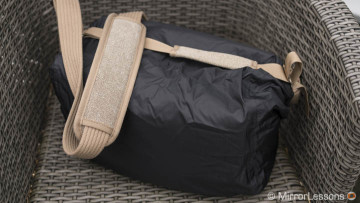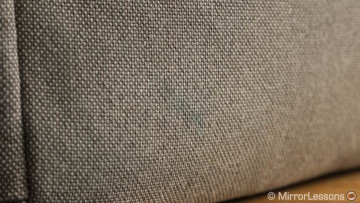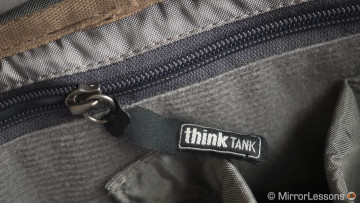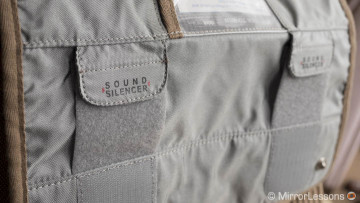The ThinkTank Retrospective series is an excellent line-up of bags. They have a simple design, are comfortable to carry, accommodate lots of gear thanks to the soft insides and most importantly, have lots of pockets. The series now comprises 7 bags excluding the leather series which has a special leather cover on the flap and shoulder pad.
The Retrospective 6 is the latest addition and aims to be a hybrid solution for mirrorless cameras and DSLRs. Of course we tested the bag with the former and found that it has some very interesting characteristics especially if you need to carry lots of gear.
Main specs
- Internal Dimensions: 33 x 19 x 13.5 cm
- Exterior Dimensions: 34.5 x 20 x 17 cm
- Front pocket: 27 x 16 x 2.5 cm (fits 8” tablet)
- Exterior material: water-repellant (DWR) and polyurethane coating, sand-washed 100% cotton canvas
- Interior material: 210D silver-toned nylon, polyurethane backed velex liner & dividers
- Weight: 1.2 kg (with all accessories)
[toc heading_levels=”3″]
Design and build quality
The bag has a minimalistic design. Outside it is mostly made of sand-washed cotton canvas with a water-repellent coating. Inside you will find polyurethane and silver-toned nylon. Light rain won’t harm it even though the material isn’t completely water resistant. This is why the brand provides a separate rain cover if the weather becomes too severe. It is easy enough to put on and doesn’t get in the way of the two straps.
The bag is available in three different colours. The one you see in this article is the lighter version (sandstone) but you can also get the darker pinestone or the black version. Personally I find the pipestone version to be the most attractive.
The quality of the finish and stitching is good. I’ve used the bag intensively for the past two months in various conditions and everything is working well. I only have one comment: the bag is meant for urban use rather than nature/country side use. Dust and other elements can leave stains on the canvas and might not be so easy to get rid of. The materials may also start to degrade a little (especially at the borders).
The insides of the bag are soft which means that its form will adapt easily to extra bulk when it is fully packed. This is an aspect I appreciate a lot about the Retrospective 6: you are not limited by its dimensions and it is easy to squeeze in something extra.
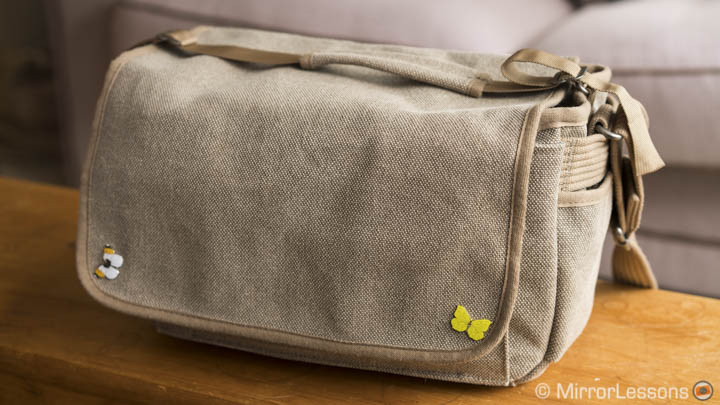
The bag has a good size for a mirrorless camera if you need to carry one or two bodies and multiple lenses. It is light so it doesn’t add too much to the overall weight.
Ease of use
The bag comes with shoulder and hand straps, a main compartment with lots of dividers, four large pockets and four side pockets. It is hard to find a real flaw considering the amount of gear and accessories you can pack inside.
Main compartment
The main compartment is large not only in terms of width but also depth. It comes with three main dividers and 4 small dividers which means you can create up to 8 individual spaces inside. On the left and right side you will also notice internal flaps for extra protection.

Two out of the three main dividers can also be bent on top if you want to insert a camera with a lens attached and let it rest above the other compartments.
The possibility to create so many small spaces becomes very appealing for Micro Four Thirds users or Sony APS-C/Fuji users who want to carry primes or small zoom lenses. If you don’t keep the lenses mounted, you can easily fit two Micro Four Thirds bodies and 6 lenses as you can see in the image below. With APS-C gear the number of lenses will probably fall to 4 unless you pack very small primes or pancake-type lenses.
- Configuration 1: E-M1, GX80, 6 lenses (2 mounted on the cameras) and a few accessories
- Configuration 2: X-Pro2 with 35mm 1.4, a6300 with 55mm 1.8, X100T and RX1r II
[twentytwenty]


[/twentytwenty]
In the main compartment you also find two small collapsible pockets at the sides. You can secure them with a velcro strap or leave the strap inside for quicker access. I chose the latter most of the time because I find that the closure gets in the way. I use these two pockets for batteries and a little air pump. Note that if you fill these side pockets too much, you will lose some space in the main compartment.

Pockets
As I said in the introduction, the nice thing about this bag and the Retrospective series in general is the number of pockets available.
On the front you will find a main pocket that can house an 8 inch tablet such as an iPad mini. You can close it with a velcro strap on top or keep it inside to access the pocket easily. There is also a webbed loop to attach a carabiner or similar items.
On the inside of the bag you will find two main pockets. The first is located on the front and once again can be closed with a velcro strap. It has a main divider inside so you can separate flat documents or similar items. It includes a few small pockets to accommodate a couple of pens and business cards. You also get a buckle which is useful to attach and secure your keys for example.

Although I like how this internal pocket is organised, I would have inverted it with the front pocket. I prefer to have the small pockets for pens and similar accessories out front as I find it easier to access. However I admit that the way this internal pocket has been designed gives more security to sensitive documents (like a passport).
An even more secure third pocket is on the inside but located at the rear. It can be closed with a robust and smooth zipper. It has only one compartment and can also fit an 8” tablet but it would be more uncomfortable to take it out or to close the zipper.
The last large pocket is found on the outside of the bag and is secured with another zipper. I admit I never felt the need to use all four pockets most of the time but they are more than welcome as they let you divide up documents and keep everything organised.

Since I already mentioned the two collapsible side pockets on the inside, the last two pockets to talk about are the two on the outside. I find them useful to insert a cleaning cloth or rain cover but they’re also a good place to house a smartphone. They are not large enough for a bottle of water. The extra “band” on top can help to hide the item or make it more visible.
[twentytwenty]
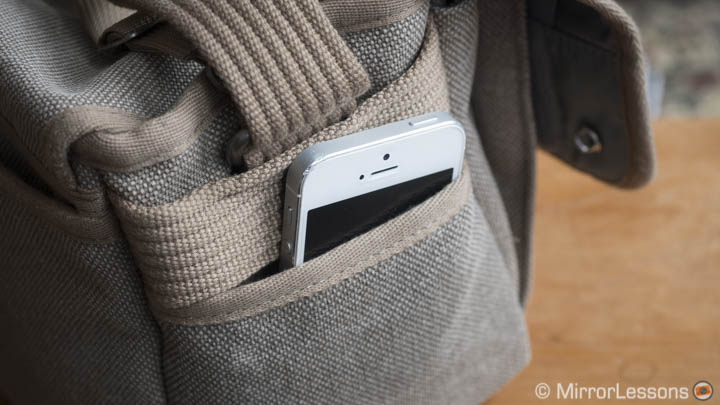
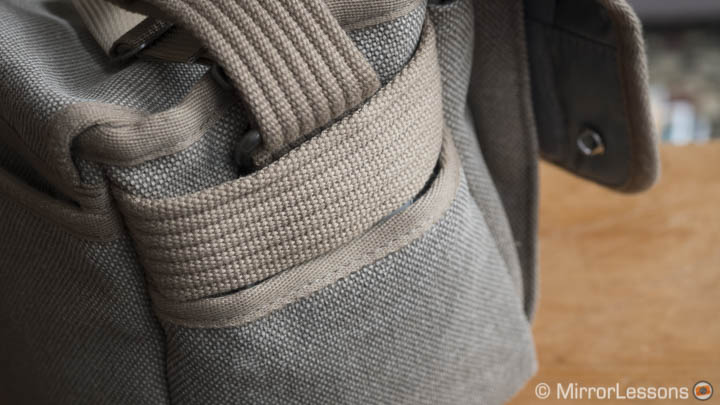
[/twentytwenty]
Closing and opening
The main compartment and three out of the four main pockets are accessed by lifting the main flap of the bag. It can be closed with two large velcro pads that can be silenced for more discretion. However, by doing so, there is no other way to close the bag. An additional buckle or magnets would have been a welcome addition.
Carrying: shoulder and hand strap
The main shoulder strap is very comfortable thanks to the large, cushioned non-slip pad. The strap can be adjusted in length and feels very robust. It is also easy to fold if necessary.
[twentytwenty]

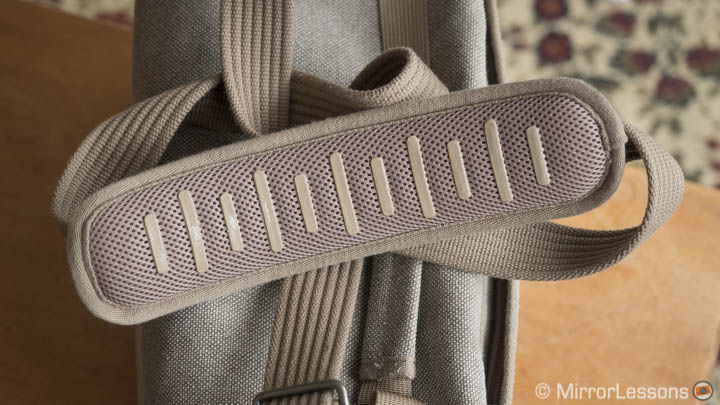
[/twentytwenty]
The hand strap can also be adjusted in length and makes it easy to grab the bag or move it from one place to another. It can be removed if not needed but personally, I always consider this feature a “must have”.
How much gear can I carry? A practical example
As usual with our bag reviews, you can see a practical example of the amount of gear you can carry inside the Retrospective 6.
The example below shows the maximum you can fit inside the bag but please note that it can become uncomfortable to remove certain items when everything is packed tight like this.
It can work if you mainly use the bag to move your gear from one location to another but if you need to reach your camera and lenses in-between while on the move, packing a little bit less can result in a better user experience.
Main compartment:
- M.Zuiko 75mm f/1.8
- Lumix 35-100mm f/2.8
- OM-D E-M1 with 12-40mm f/2.8 attached
- Battery charger
- Nissin i40
- GX80 with M.Zuiko 45mm attached
- M.Zuiko 60mm macro
- Leica DG 25mm f/1.4
- 2 E-M1 and 4 stylo spare batteries, small air pump in the internal side pockets
External front pocket:
- iPad Mini
Internal front pocket:
- Rain cover
- Pens
- Business card
External rear pocket:
- Notepad
Internal rear pocket:
- Lee Seven5 Little stopper with case
- Lee Seven5 holder and adapter ring
- Hoya circular infrared filter
Internal side pockets:
- 2 BLN-1 batteries
- 4 AA type batteries
- Air pump
External side pockets:
- iPhone
- Cleaning cloth
Where the bag doesn’t work that well in my opinion is with bigger lenses like a Sony 24-70mm 2.8 GM mounted on the A7r II. You have to remove most of the dividers and there won’t be much room for other items. The same reasoning can be applied to large Micro Four Thirds and APS-C telephoto lenses. You could insert the lens in a vertical orientation but depending on the specific model, it could stand above the maximum height of the bag itself which could prevent the bag from closing properly.
Conclusion
The Retrospective 6 isn’t revolutionary. However, it does include all the positive aspects of the other bags in the series and proposes a shorter yet deeper design that makes it easier to fit and organise multiple lenses and camera bodies, with the best fit being compact mirrorless systems like Micro Four Thirds or APS-C (as long as the lenses aren’t too large).
The build quality is good but keep in mind that the bag is designed for urban use rather than adventure or nature photography, as dust or rough conditions can consume the materials more easily or leave some stains. Perhaps on the darker versions, the latter would be less noticeable.
The number of pockets and the options for organising your belongings make this bag a very good choice if you like to pack heavy and want to be able to access anything at anytime without having to move one thing to access another.
 What I like about the ThinkTank Retrospective 6:
What I like about the ThinkTank Retrospective 6:
- Minimalistic yet elegant design (especially the black or pinestone versions)
- Good build quality
- Lots of pockets
- The main compartment can be subdivided into 8 sections with the supplied dividers
- Allows you to fit lots of gear with quick access
- Very comfortable shoulder pad
 What I don’t like about the ThinkTank Retrospective 6:
What I don’t like about the ThinkTank Retrospective 6:
- The materials are best suited to urban use because it can collect some dust or stain if used in rough conditions
- The main flap only closes with velcro. If you silence them, there is no secure closure
- I would have inverted the external front pocket with the internal front pocket as the latter can house small items you may want to access more quickly
- Larger lenses (telephoto zooms or full frame zooms) may not fit as well as smaller lenses




